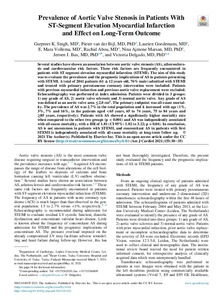Prevalence of Aortic Valve Stenosis in Patients With ST-Segment Elevation Myocardial Infarction and Effect on Long-Term Outcome
Goedemans Laurien; Abou Rachid; Vollema E Mara; Bax Jeroen J; Singh Gurpreet K; Marsan Nina Ajmone; Delgado Victoria; van der Bijl Pieter
https://urn.fi/URN:NBN:fi-fe2022012710552
Tiivistelmä
Several studies have shown an association between aortic valve stenosis (AS), atherosclerosis and cardiovascular risk factors. These risk factors are frequently encountered in patients with ST-segment elevation myocardial infarction (STEMI). The aim of this study was to evaluate the prevalence and the prognostic implications of AS in patients presenting with STEMI. A total of 2041 patients (61 +/- 12 years old, 76% male) admitted with STEMI and treated with primary percutaneous coronary intervention were included. Patients with previous myocardial infarction and previous aortic valve replacement were excluded. Echocardiography was performed at index admission. Patients were divided in 3 groups: 1) any grade of AS, 2) aortic valve sclerosis and 3) normal aortic valve. Any grade of AS was defined as an aortic valve area <= 2.0 cm2. The primary endpoint was all-cause mortality. The prevalence of AS was 2.7% in the total population and it increased with age (1%, 3%, 7% and 16%, in the patients aged <65 years, 65 to 74 years, 75 to 84 years and >= 85 years, respectively). Patients with AS showed a significantly higher mortality rate when compared to the other two groups (p < 0.001) and AS was independently associated with all-cause mortality, with a HR of 1.81 (CI 95%: 1.02 to 3.22; p = 0.04). In conclusion, AS is not uncommon in patients with STEMI, and concomitant AS in patients with first STEMI is independently associated with all-cause mortality at long-term follow up. (C) 2021 The Author(s). Published by Elsevier Inc.
Kokoelmat
- Rinnakkaistallenteet [19207]
